|
Matters Arising
I am told that ‘blogs’ (whatever they are) on the interweb often have ‘Comment’ sections whereby readers can express an opinion on what the ‘blogger’ has been ‘blogging’ about. This all sounds dangerously democratic to me and the idea of promoting opinions which may disagree with mine are to be discouraged at every turn.
There are, however, a number of Matters Arising following my October column, received here at Ripster Hall through media ancient and modern, which I must report before we embark on this month’s agenda.
Firstly, Catherine Aird showed that the tradition of communicating by post card still lives by sending me a charming one showing that famous Soho watering-hole The French House in Dean Street and informing me that she had just enjoyed a visit from the sister of the late Gaston Berlemont, the legendary proprietor of the establishment, who was the first London publican I ever met, when the pub still went under its original name of The York Minster.
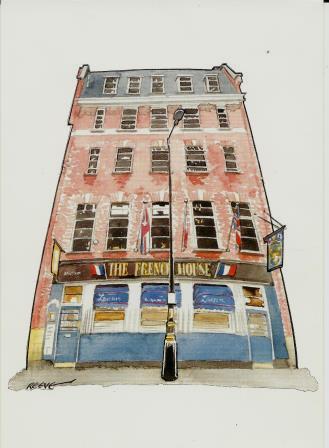
Secondly, I must report charming and complimentary missives from Irish noirista Ken Bruen and millionaire playboy Prince Ali Karim, both saying how much they enjoyed last month’s ramblings. As it so happens, I have discovered photographic evidence from a few years ago, of these two reprobates in a simulated late night ‘arrest scenario’ with officers of the law in Las Vegas; all, I am sure, in the name of research.
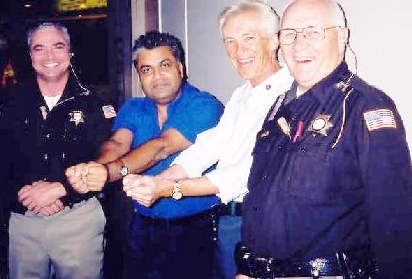
My report that I was now officially known as a, if not the, UK Crime Fiction Guru in New Zealand, if not, indeed, the entire Southern Hemisphere (although Bouvet Island still holds out as a hot-bed of Scandinavian crime writing), resulted in Denise Danks writing to demand a picture of me garlanded and cross-legged on a bed of nails. I somehow doubt that will happen any time soon.
I am inordinately proud of the title Crime Guru, which was awarded to me for my championing of the work of Paul Thomas, Middle Earth’s finest crime writer in my not-so-humble opinion. That in turn prompted the charming Francois von Hurter to get in touch with the excellent news that his Bitter Lemon Press will be publishing Paul Thomas’ new novel Fallout in March 2015.
Finally, it serves me right for criticising Michael Connelly’s rather – shall we say hurried – signature when signing books for readers, for I learn that he has another Harry Bosch thriller out this month, The Burning Room, published by Orion, who also inform me that the television series Bosch, of which Michael is an executive producer, is currently being filmed in Los Angeles after a pilot film was aired in America in February.
And now, as they say, to our muttons; though quite who says that, or indeed why, is a mystery.
Party Season
Crime writing’s Autumn ‘Season’ got off to a brilliant start with a superb party to celebrate the launch of Martina Cole’s twenty-first bestseller The Good Life (Headline) and the fact that my prediction that it would go straight to the top of the bestseller list came true.

To be honest, that wasn’t the most difficult thing to predict but just to make sure I could not be accused of misleading my readers, I checked with the trade paper The Bookseller to find that The Good Life went immediately into the number one slot and retained its lofty perch for a second week (and I quote): “shifting 11,484 units.” Now I am tempted to say that in my day, “units” were better known as “books” but it does clarify something which has been troubling me for a while. On my last regular medical check-up, my doctor sternly warned me to limit my consumption to ‘no more than 9-10 units per day’. Now I realise that he meant reading no more than nine or ten books a day, I will happily agree to follow his advice.
Always the generous host, Martina’s parties bring out the great and good of the crime scene and Professor Barry Forshaw, seen here with Maxim Jakubowski, Prince Ali Karim and Shots editor Mike Stotter.

For me there was the added pleasure of meeting up with my old chumette Denise Danks and reliving the days when we first enjoyed the party season, an unbelievable twenty years ago when the world was young, or at least younger.
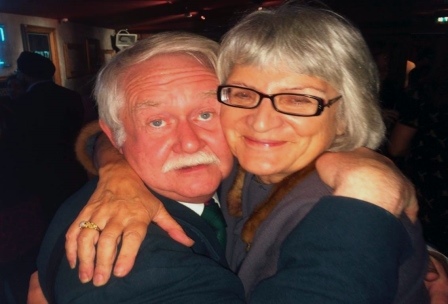
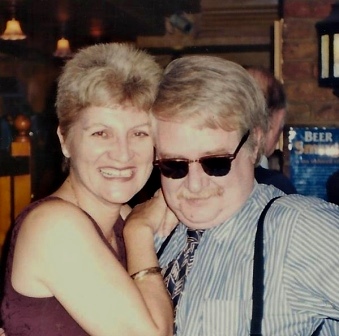
Barely recovered from Martina’s generous hospitality, I found myself in the famous ‘showbiz’ restaurant Joe Allen’s which was clearly the scene of some terrible crime, with blood-spattered tables, body parts and bottles of arsenic.
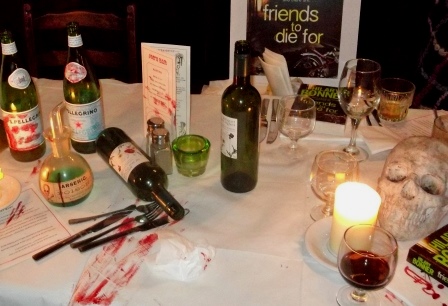
It was, of course, a piece of clever scene-setting by publisher Pan for the launch of Hilary Bonner’s new paperback Friends to Die For. To mark the event, Hilary was wearing a specially commissioned Friends to Die For t-shirt but was unable to adequately model it for the Shots cameraman as she was far too busy signing copies of her book for a seemingly endless queue of fans.
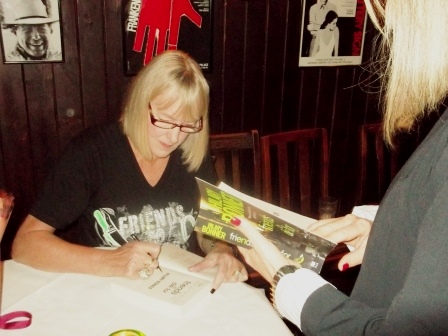
Match of the Day
Football – or ‘Soccer’ as our colonial cousins insist – has not been the most obvious setting for crime novels, which is slightly surprising given the amount of violence and skullduggery which goes on both on the pitch and in the board room.
It is not unknown, of course. The prolific John Creasey wrote Inspector West Kicks Off in 1949 and I remember reviewing The World Cup Murders by American Herbert Resincow (supposedly with Pele) in 1990. It has stuck in my mind for its awfulness when it came to trying to explain the beautiful game to the uninitiated (Americans). Perhaps most famously, though, was Leonard Gribble’s 1939 novel The Arsenal Stadium Mystery, which was filmed using actual members of the Highbury Faithful.

Arsenal may have moved to a new stadium, but it still has faithful fans and quite a lot of ‘celebrity’ fans which, over the years, have included: Ronnie Biggs, Mad Frankie Fraser, Osama Bin Laden(!), Fidel Castro and of course Piers Morgan, not to mention more sensible people such as Nick Hornby, Mo Farrah and Roger Daltrey. It seems that best-selling thriller writer Philip Kerr is also a lifelong “Gooner” and has forsaken (temporarily one hopes) those very mean streets of Nazi Germany and his superb series hero Bernie Gunther for the world of heavy leather balls, below-the-knee shorts and jumpers for goal-posts in his new novel January Window from Head of Zeus this month.

Of course football has probably moved on since my day and Philip’s novel reflects the state of the modern game. I am slightly worried that he might have gone too far by setting his murder plot in a London club which is owned by an East European oligarch and has a foreign manager. Where on Earth does Philip get such fantastical ideas from?
His hero, Scott Manson, is a retired Arsenal centre back who lives in Chelsea (morally dubious I would have thought), but is now team coach for ‘London City Football Club’ who play in East London somewhere in the disputed border zone between Millwall and West Ham. Manson, who personally has no reason to believe that our police are wonderful, is unwillingly drawn into solving the murder of the manager of London City.
I am sure Scott Manson will come through with flying colours – as more adventures are planned – but just in case he gets nut-megged, carded or fouled, it would be nice to think Bernie Gunther was sitting on the subs’ bench.
[I realise that most of my North American readers will have probably glazed over by now but I really don’t care after forty years of having to put up with unfathomable references to baseball in American crime fiction.]
Emerald Red Eye
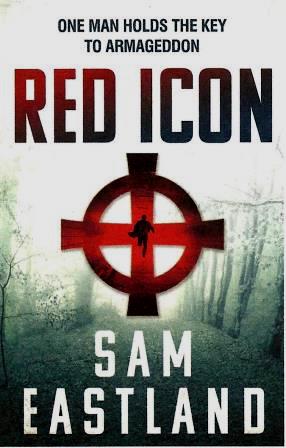
I have been a fan of Sam Eastland’s ‘Pekkala’ thrillers set in Stalin’s Russia since the series started, and before I learned that ‘Sam Eastland’ was the pen-name of Paul Watkins, an extremely talented novelist whose work I have admired for twenty years.
Consequently I am delighted that a new instalment, Red Icon, taking the series into the year 1944, will be published by Faber in April next year. Although I know little of the plot – the Inspector Pekkala books I would ‘buy unseen’ – I confidently recommend Red Icon, but with the proviso I expressed last year when The Beast in the Red Forest came out. This is such a complex series, spanning (so far) a quarter of a century of turbulent history, including two world wars, that I would advise newcomers to start at the beginning (with Eye of the Red Tsar) and that is not something I say lightly as usually I have little time for obsessive-compulsives who refuse to even consider a crime novel no matter how forcefully recommended, because they have not read the earlier ones in the series. I do think, though, that a certain amount of anal-retentiveness should be allowed here as the Pekkala stories are well worth the discomfort.
Constable Country
Although I hail from the territory of the Brigantes, I have lived in the land of the Iceni (Oh, for God’s sake - look them up) for many years. In fact I am very proud to inhabit that East Anglian crime-writing Bermuda triangle which was, at one time or another, home to Margery Allingham, Dorothy L. Sayers, P.D. James, Ruth Rendell, Jonathan Gash and, for a portion of the 1960s, Patricia Highsmith.
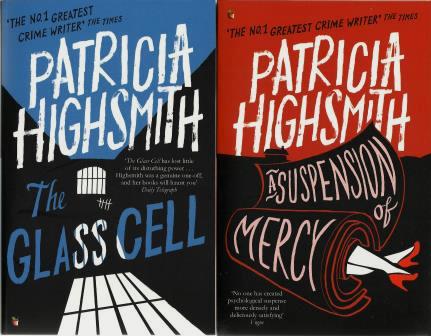
This month Virago Modern Classics are to publish very attractive new editions of three of Pat Highsmith’s ‘Suffolk’ novels, including A Suspension of Mercy which is actually set in Suffolk, along with The Glass Cell and Those Who Walk Away.
It is a long-standing personal career regret that I never got the chance to review a new Patricia Highsmith novel when I worked for the Daily Telegraph (she died in 1995) for we had the headline The Talented Miss Highsmith by the far-less-talented Mr Ripley all ready to go.
Talented crime writers exist in all parts of the Eastern Marches, of course, not just in my particular Bermuda triangle. Living on the edges  of Fen Country himself, Jim Kelly’s atmospheric ‘Shaw and Valentine’ police procedurals show the North Norfolk landscape and Heritage Coast in all their glory. His latest, At Death’s Window (Crème de la Crime) also shows the danger of that beautifully desolate coastline, as a family of visitors have to be rescued from a sandbank when trapped by a rapidly-encroaching tide (in reality, quite a common occurrence), but also on the sandbank is a tethered body which is way beyond rescue. of Fen Country himself, Jim Kelly’s atmospheric ‘Shaw and Valentine’ police procedurals show the North Norfolk landscape and Heritage Coast in all their glory. His latest, At Death’s Window (Crème de la Crime) also shows the danger of that beautifully desolate coastline, as a family of visitors have to be rescued from a sandbank when trapped by a rapidly-encroaching tide (in reality, quite a common occurrence), but also on the sandbank is a tethered body which is way beyond rescue.
The clever – and topical – plot develops along twin lines: activists campaigning against local houses being bought up as second, holiday homes by ‘outsiders’ the only popular second-home owner in Norfolk being H.M. the Queen, and a developing turf war over control of the lucrative samphire crop (samphire being a sort of ‘sea-asparagus’ which grows on the coast or in river estuaries if you have to ask).
One of the newest and brightest rising stars on the crime scene here in the East is Essex-based Eva Dolan, who uses Peterborough as a setting for investigations by her Hate Crimes Unit detectives Mel Ferreira and Dushan Zigic.
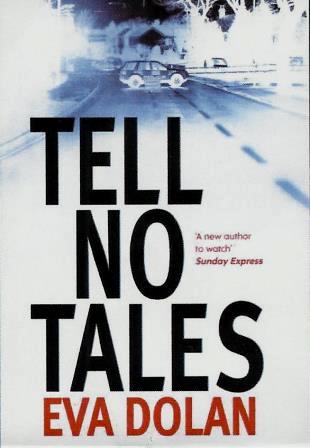
Eva Dolan’s second novel, Tell No Tales is published by Harvill in January and will no doubt enhance the reputation she garnered with her debut, Long Way Home, published earlier this year. I was impressed with Long Way Home as, I know, was John Harvey for we discussed the book at length in the summer. Not that John is an East Anglian by birth or adoption as far as I am aware, but he does know a fair bit about writing goodcrime novels.
Lion Kings
Australian Tony Park writes about Africa and must be heartily sick of the epithet ‘the heir to Wilbur Smith’ especially as Wilbur Smith shows no sign of retiring just yet. However, Park is his own man and I discovered he could tell a good tale when I reviewed his African Sky, set in Rhodesia during World War II, when it first appeared here in 2006.

Now published by Quercus, his latest novel, The Hunter, is just out, and features safari guide turned private investigator Hudson Brand hunting a missing woman across Zimbabwe and Kenya’s Maasai Mara game reserve, whilst he himself is being tracked by a South African detective who suspects him of being a murderer.
Keeping your Frenemies Close
I have discovered a new sub-genre of crime fiction, or at least been told about one by the publishers (Weidenfeld) of Harriet Lane’s new novel Her which comes out in January. The book deals with the ‘friendship’ of two women which turns out to be anything but friendly and has given rise to the term “frenemy thriller”.
|
|
Murder Most Historical
I cannot remember who first cracked the awful joke about the murder of Leon Trotsky in 1940 (“Was it an axe-ident or was somebody picking on him?”) but Trotsky was assassinated – in exile in Mexico on the orders of Stalin – by the Spanish Marxist and Soviet agent Ramon Mercader. about the murder of Leon Trotsky in 1940 (“Was it an axe-ident or was somebody picking on him?”) but Trotsky was assassinated – in exile in Mexico on the orders of Stalin – by the Spanish Marxist and Soviet agent Ramon Mercader.
Mercader’s story – he served twenty years in a Mexican prison and died in Cuba in 1978 – is now the subject of the ambitious new novel, The Man Who Loved Dogs by Cuba’s crime writing maestro Leonard Padura and is published as a substantial paperback here by Bitter Lemon Press in December.
Back in 1996 that modern beat combo The Prodigy had an international Number One hit with their ballad Firestarter. According to that most prolific purveyor of historical mysteries Paul Doherty, the correct 14th century term would have been Ignifer, or ‘Fire Bringer’.
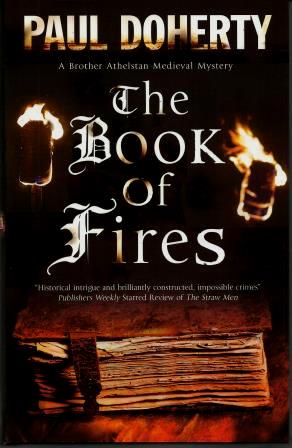 In his latest ‘Brother Athelstan’ mystery, The Book of Fires (Crème de la Crime), Doherty has a very scary Ignifer stalking the streets of London in 1381, dispensing violent death by means of the legendary ‘Greek Fire’ on the principle of the Molotov cocktail. The deaths all seem connected to the trial and execution (by burning at the stake) of Lady Isolda Beaumont, convicted of the murder of her well-connected husband, and the disappearance of the manuscript of the mysterious Book of Fires. Despite this concentration on things aflame, this is quite a chilling read. In his latest ‘Brother Athelstan’ mystery, The Book of Fires (Crème de la Crime), Doherty has a very scary Ignifer stalking the streets of London in 1381, dispensing violent death by means of the legendary ‘Greek Fire’ on the principle of the Molotov cocktail. The deaths all seem connected to the trial and execution (by burning at the stake) of Lady Isolda Beaumont, convicted of the murder of her well-connected husband, and the disappearance of the manuscript of the mysterious Book of Fires. Despite this concentration on things aflame, this is quite a chilling read.
Delving even deeper into history, one of my favourite writers of mysteries set in Roman Britain, Rosemary Rowe, has a new novel out featuring Libertus, her second-century mosaic craftsman and occasional detective of Glevum (Gloucester).
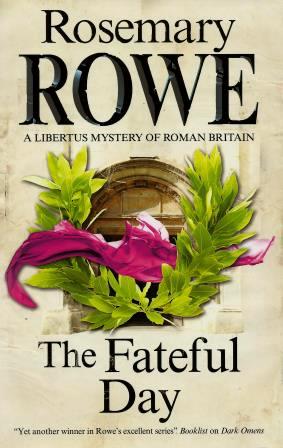 The Fateful Day is, I believe, the fifteenth Libertus adventure and has our agreeable and engaging narrator hero stumbling upon a body hanging from a hook at the villa of his patron. The Fateful Day is, I believe, the fifteenth Libertus adventure and has our agreeable and engaging narrator hero stumbling upon a body hanging from a hook at the villa of his patron.
Naturally, this being AD 192, the Roman Empire is in political turmoil and if anyone doubts the scholarly research that has gone into this series, they can do no better than read the author’s erudite Foreword which details the political situation in Rome at the time, following the death of the bonkers Emperor Commodus and the short-lived reign of his successor Pertinax – basically the period not covered by the end-credits of the film Gladiator.
Rosemary Rowe (aka the successful novelist Rosemary Aitken) is quite an authority on Ancient Rome and Roman Britain (particularly the Glevum area) as I know having spent a hot summer’s evening with her in Heffer’s bookshop in Cambridge discussing Latin obscenities and the impact of imperial deflation on the Claudian economy.

The Spies Have It
It is very fitting that this year of commemorations of the First World War should see one of the best historical spy thrillers of recent time, set in 1917 and revolving around the bloody slaughter on the Western Front, the tension of spying in occupied Belgium and the political infighting between the British army and the formative secret service.
I had high hopes of Andrew Williams’ new novel – as he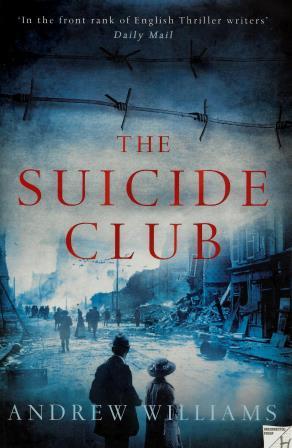 has already, with three previous books, shown himself to be a prodigious talent in the field of historical spy-fi – but The Suicide Club, published by Hodder this month, exceeded all my expectations. It really is very, very good: comprehensively researched, carefully plotted and quite brilliantly written. has already, with three previous books, shown himself to be a prodigious talent in the field of historical spy-fi – but The Suicide Club, published by Hodder this month, exceeded all my expectations. It really is very, very good: comprehensively researched, carefully plotted and quite brilliantly written.
Williams’ hero is soldier Sandy Innes, a sensitive Scot and a Roman Catholic (and therefore suspect in some military eyes), who has survived the horrors of the trenches, earning him the nick name ‘Lazarus’, only to face the horrors of undercover warfare and establish a highly efficient espionage network of agents operating in German-occupied Belgium and neutral Holland. His spy ring – known as ‘Ramble’, the name of one of its best (female) agents – produces top-grade intelligence on German troop movements behind the lines, but is that intelligence end-product being taken seriously at Field Marshal Haig’s headquarters? Where, in fact, is Army HQ getting its intelligence? With the third battle of Ypres looming, it becomes a vital question.
Innes is pulled out of the occupied Low Countries by his secret service boss and sent undercover to a potentially far more treacherous environment – Haig’s headquarters in France. Officially he is there to train the ‘Suicide Club’ of spies to be sent behind enemy lines, but in reality he is there to spy on Haig’s staff officers and their private source of intelligence, the mysterious ‘Faust’ network, which might just be a German counter-intelligence initiative.
The Suicide Club is a dazzling mix of spy fiction and history ranging from the battlefields of Flanders to brothels in Antwerp to Lloyd George’s Downing Street, and certainly the best spy story I’ve read this year. Andrew Williams is elbowing his way into a place at the top table of spy-writers and could soon find himself dining alongside Le Carré, Deighton, Littell and Furst.
The Tyler(s) Now Arriving…
To those, like me, who discovered only late after the event that there had been a new L. C. Tyler novel in September, I say “Worry ye not” for another one is due any moment now. In fact, Tylers seem to come not in multiples of two but of two-and-a-half.
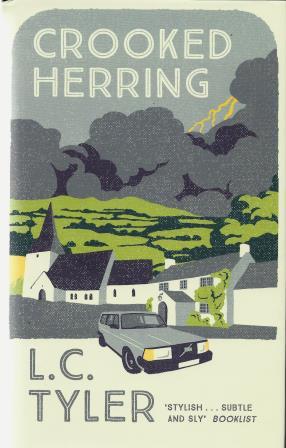 
The September Tyler, Crooked Herring, was the latest in his series of gentle ‘Herring’ spoofs on the traditional British whodunit, but the November Tyler arriving in a bookshop near you any day now, is A Cruel Necessity, a new departure for the author: a 17th centuryhistorical mystery and the first in a planned series.
In addition, Len has co-edited with my distinguished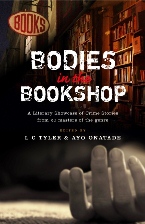 and voluptuous Shots colleague Ayo Onatade the long awaited anthology Bodies in the Bookshop, published this month by Ostara. The collection celebrates bookshops, Cambridge and, unsurprisingly (the clue being in the title), the famous “Bodies in the Bookshop” events held at Heffers bookshop in Cambridge. and voluptuous Shots colleague Ayo Onatade the long awaited anthology Bodies in the Bookshop, published this month by Ostara. The collection celebrates bookshops, Cambridge and, unsurprisingly (the clue being in the title), the famous “Bodies in the Bookshop” events held at Heffers bookshop in Cambridge.
Contributors are drawn from the good and the great of the British crime-writing establishment (it says here) and include: Simon Brett, Alison Bruce, Ruth Dudley Edwards, Michael Gregorio, Suzette A. Hill, Peter Lovesey and Andrew Taylor.
Whilst it is ‘top of mind’ as the young people say, I must mention that Heffers’ renowned Christmas Chrime (sic) Party will take place on 11th December and though I have no details as yet, these are usually jolly affairs with copious amounts of mince pies and mulled wine and large amounts of serious discussion about crime fiction from some very well-read fans of the genre.
Before then, however, Heffers are sponsoring an evening of James Ellroy in conversation with Nicola Upson at the Cambridge Arts Picture House on 18th November. Sparks could fly at this event – they usually do whenever James Ellroy is present – and I only hope that the Picture House (a splendid, friendly venue in my experience) has its fire insurance up-to-date.
Mapping those Mean Streets
I have read rave reviews of The Raymond Chandler Map of Los Angeles, compiled by Kim Cooper and Paul Rogers, and although I have not actually seen one myself, it sounds a highly decorative and very thoughtful Christmas present for fans of the genre.

I find it particularly interesting that most of the rave reviews stress that the map is of high quality because it is “litho-printed in England” and that makes me rather proud.
Lonely is (and with) the Hero
One of the nicest ironies in British thriller fiction was the idea that the ruthlessly efficient, ice-cold government assassin David Callan should have only one friend – a fellow ex-jailbird and professional thief with a terrible body odour problem called ‘Lonely’. Ironic because it is Callan – supremely good at a job he despises – who is the loneliest man on the planet.
Created by James Mitchell in 1967, originally for the one-off television play A Magnum for Schneider, the character Callan went on to feature in four series of highly successful television adventures, a movie version, five novels and more than two dozen short stories. Callan was brilliantly portrayed throughout by actor Edward Woodard, seen below with author Mitchell and his wife on the set of the 1974 movie Callan. [Picture courtesy of Peter Mitchell]

Callan was a real television ‘event’ in its day (1967-72) and attracted viewing figures which a modern producer would kill for. It attracted controversy – Callan the anti-hero was, after all, a killer – for its violence and cynicism as Callan was often shown to be the noble, moral figure where his spymaster politician bosses were anything but. James Mitchell had already created one hard-as-nails, working-class antidote to James Bond in his novels featuring secret agent John Craig (written under the pen-name James Munro) and was to go on to create another in Jack Ford, the dubious hero of Mitchell’s next television hit When the Boat Comes In.
Between the end of Callan and the first series of When the Boat…, Mitchell kept the fans happy with a series of Callan short stories which became a regular feature in the Sunday Express before syndication to newspapers in Malayasia and Australia. These short stories had, forty years on, become something of the Holy Grail in Callan mythology, especially when the TV series and the movie became available on DVD and the Callan books began to be reissued by Top Notch Thrillers under the editorship of…well, er…me.
It was whilst working with James Mitchell’s son Peter on the reissue of Death and Bright Water that the subject of these ‘lost’ but not forgotten short stories came up. Peter thought there were perhaps a dozen but could not find copies of any in his father’s papers (James died in 2002 and wrote long before the days of computer hard drives and memory sticks). One internet source said there were nine Express stories, another said 14. After a year of research (and the British Library is now sick of the sight of me), I found 24.
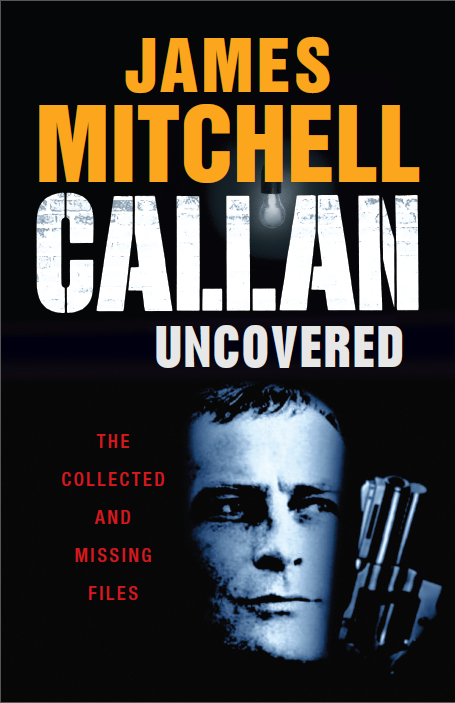
These stories, plus an original Mitchell outline treatment for an episode of Callan, an un-filmed Callan script and an Introduction by Peter Mitchell, have finally coalesced into Callan Uncovered, now published as an Ostara Original in hardback, trade paperback and eBook formats. The full story of the books gestation can be found on the Ostara Publishing website at: http://goo.gl/XUhgVv
Should have gone to Specsavers
I really should have. Not to pick up a crime writing or acting award of course, but to explore the possibilities of some new bifocals. The problem is that when I saw an advance notice of Rhys Bowen’s 2015 novel In Like Flynn, I misread it as In Like Flint, the spoof spy film from 1967.
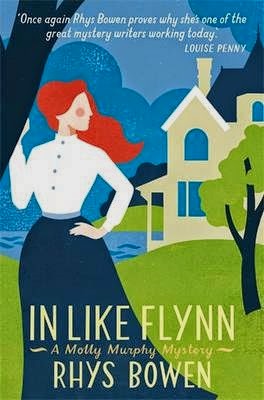 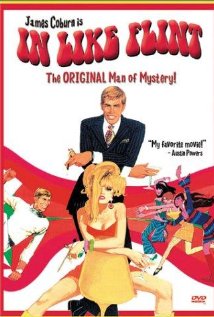
The second of two films to feature super spy Derek Flint, as played with cat-like grace by James Coburn, In Like Flint was also the last in the short-lived franchise. Despite some good sight gags spoofing the gadgetry of the Bond films, and excellent supporting performances from stalwarts Lee J. Cobb and Andrew Duggan (both trying hard to keep straight faces), the scripts were pretty dire even for crude parodies and platoons of ‘dolly birds’ were paraded at every opportunity, making the films horrendously sexist even for the 1960s.

Perhaps the lasting legacy of the Flint films was the communicator watch worn by James Coburn which clearly sparked later technological developments and famous ringtone on the US President’s hotline telephone, which I understand can these days be downloaded to a mobile phone, should one possess such a thing.
Books of the Year
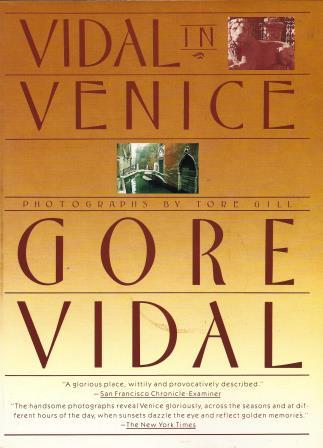 It is coming up to the time when reviewers and pundits are asked to name their ‘best books of the year’. Often they do not wait to be asked and this august column is no exception to that rule. In December, therefore, I will be suggesting crime fiction from 2014 which ought to feature on any discerning reader’s list to Santa Claus; a list, I am assured, he will be checking twice. It is coming up to the time when reviewers and pundits are asked to name their ‘best books of the year’. Often they do not wait to be asked and this august column is no exception to that rule. In December, therefore, I will be suggesting crime fiction from 2014 which ought to feature on any discerning reader’s list to Santa Claus; a list, I am assured, he will be checking twice.
In the meantime, I would crave your indulgence to recommend my two best non-crime reads of the year. These are not candidates for my personal Christmas List (whichis extensive) as I have already read them and they provided a very welcome break from the crime scene.
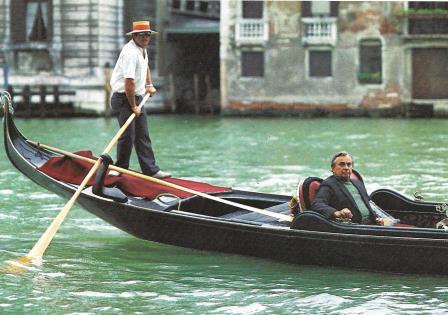
I did not know that Vidal in Venice (first published in 1985) existed until I chanced upon copy this year and though I usually avoid travel books like the plague, I could not resist this erudite history of Venice which is beautifully illustrated, even including a photograph of the author in Imperious pose in a gondola. Gore Vidal’s prose, as well as his pose, is also imperious as he fluently scans 1500 years ofhistory, peppering the text with nuggets such as: Although the Venetians have a well-defined class system, they have never had a class war. There isn’t space for one. A gem.
Freshly published in a very fine paperback edition by Head of Zeus, my other pick is The King in the North by Max Adams, subtitled ‘The Life and Times of Oswald of Northumbria’.
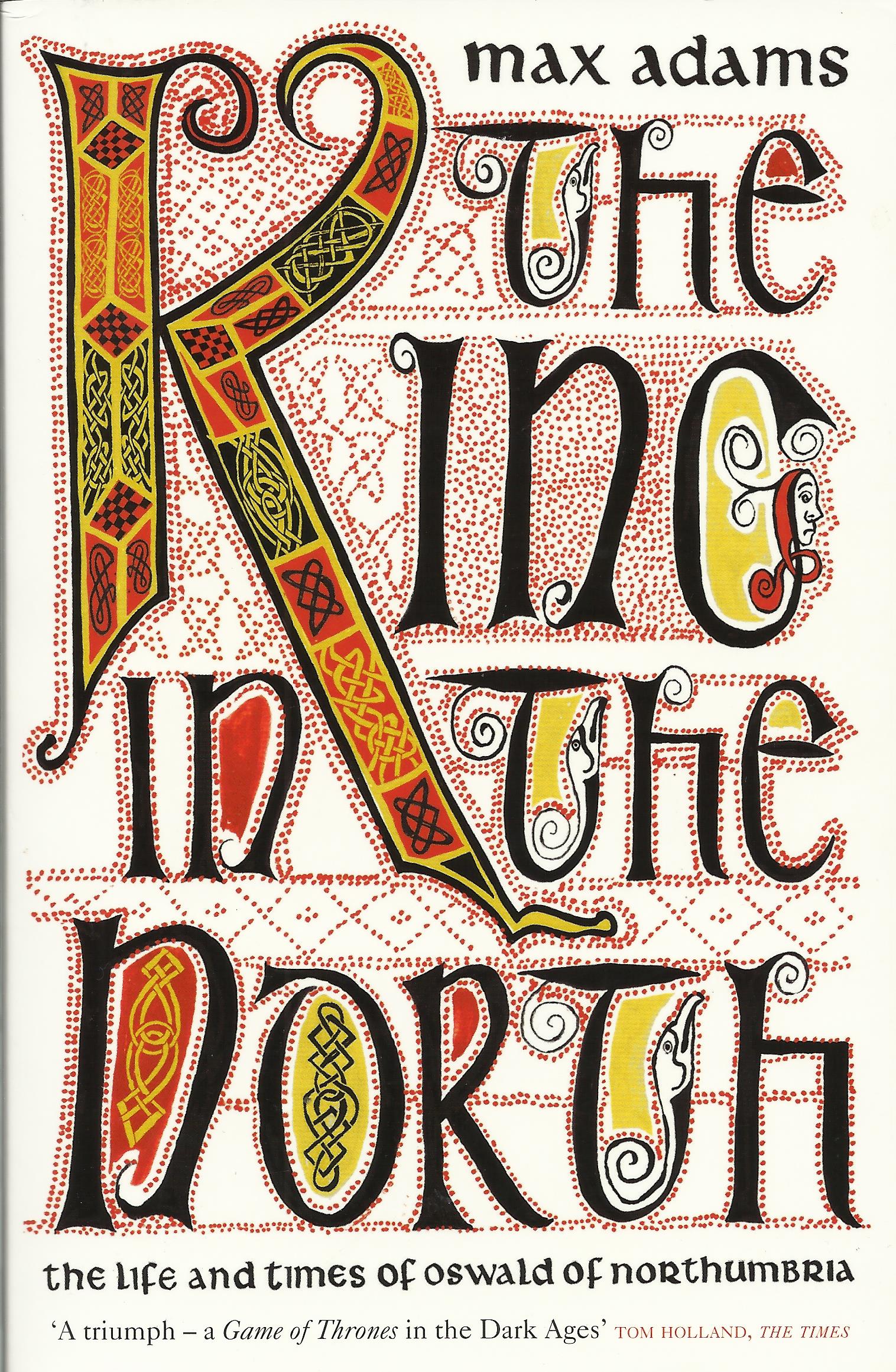 This is a splendid book containing just about everything you need to know (but were afraid to ask) about the sixth- and seventh-century ‘kingdoms’ of Deira, Bernica and Rheged, places which are now known among the soft, southern chattering classes simply as ‘the north’. Illuminating the so-called Dark Ages with all its Game of Thrones intrigue – though with less sex and no dragons – The King in the North is an immensely readable historical/archaeologicalstudy of a society anda major figure, Oswald Iding or ‘Whiteblade’, who is little known outside Northumberland. The book is also invaluable to anyone who has ever struggled with the Ecclesiastical History of England written around 731 A.D. by the Jarrow monk Baeda, known to generations of schoolboys as The Venomous Bede. This is a splendid book containing just about everything you need to know (but were afraid to ask) about the sixth- and seventh-century ‘kingdoms’ of Deira, Bernica and Rheged, places which are now known among the soft, southern chattering classes simply as ‘the north’. Illuminating the so-called Dark Ages with all its Game of Thrones intrigue – though with less sex and no dragons – The King in the North is an immensely readable historical/archaeologicalstudy of a society anda major figure, Oswald Iding or ‘Whiteblade’, who is little known outside Northumberland. The book is also invaluable to anyone who has ever struggled with the Ecclesiastical History of England written around 731 A.D. by the Jarrow monk Baeda, known to generations of schoolboys as The Venomous Bede.
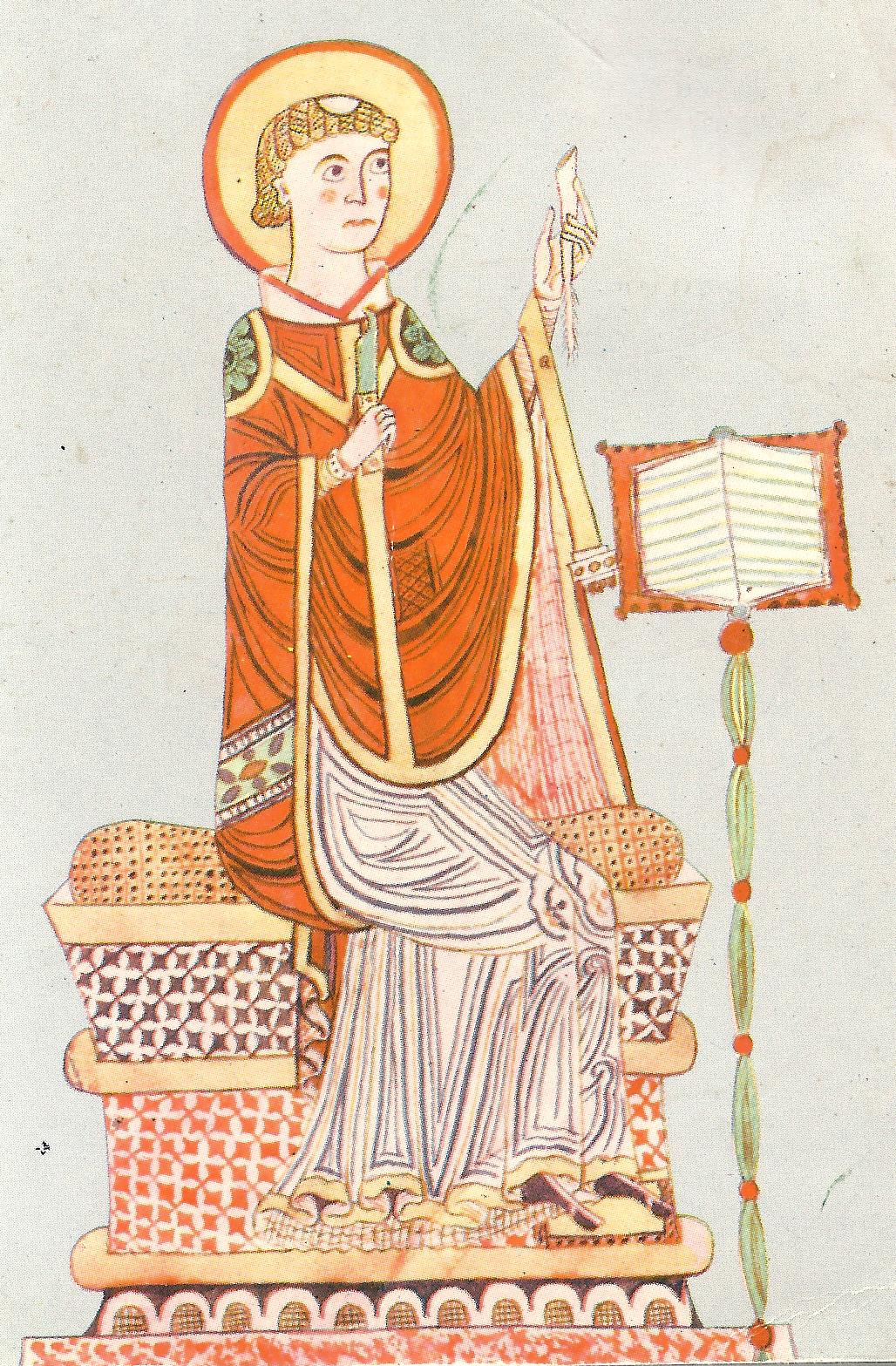
Just like Bede (above), I am sharpening my quill for a return to the world of crime.
Pip! Pip!
The Ripster
|